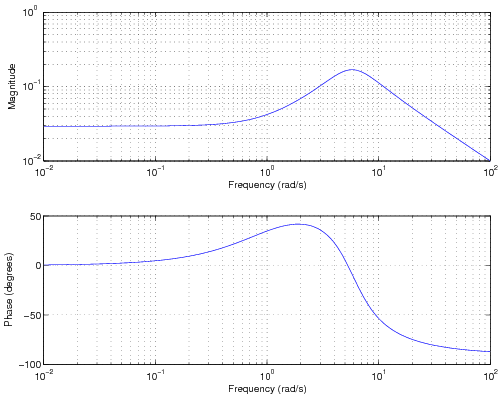| << Chapter < Page | Chapter >> Page > |
We saw in [link] that the transfer function of a linear time-invariant system is given by
If we assume that is a rational function of then we can write
where are the zeros, and are the poles of . The poles and zeros are points in the -plane where the transfer function is either non-existent (for a pole) or zero (for a zero). These points can be plotted in the -plane with “ " representing the location of a pole and a “ " representing the location of a zero. Since
we have
and
Each of the quantities have the same magnitude and phase as a vector from the zero to the axis in the complex -plane. Likewise, the quantities have the same magnitude and phase as vectors from the pole to the axis.
Example 3.1 Consider a first-order lowpass filter with transfer function
Then
The quantity has the same magnitude and phase as a vector from the pole at to the axis in the complex plane. The magnitude of the frequency response is the inverse of the magnitude of this vector. The length of increases as increases thereby making decrease as one would expect of a lowpass filter.
Example 3.2 Consider a first-order highpass filter with transfer function
Then
When , , but as approaches infinity, the two vectors and have equal lengths, so the magnitude of the frequency response approaches unity.
Example 3.3 Let's now look at the transfer function corresponding to a second-order filter
Or
The pole-zero plot for this transfer function is shown in [link] . The corresponding magnitude and phase of the frequency response are shown in [link] .


The two poles are at and the zero is at . When the frequency gets close to either one of the poles, the frequency response magnitude increases since the lengths of one of the vectors is small.
In the previous example we saw that as the poles get close to the axis in the -plane, the frequency response magnitude increases at frequencies that are close to the poles. In fact, when a pole is located directly on the axis, the filter's frequency response magnitude becomes infinite, and will begin to oscillate. If a zero is located on the axis, the filters frequency response magnitude will be zero.
Example 3.4 Suppose a filter has transfer function
The two poles are at and there is a zero at . From [link] , the impulse response of the filter is . This impulse response doesn't die out like most of the impulse responses we've seen. Instead, it oscillates at a fixed frequency. The filter is called an oscillator . Oscillators are useful for generating high-frequency sinusoids used in wireless communications.

Notification Switch
Would you like to follow the 'Signals, systems, and society' conversation and receive update notifications?